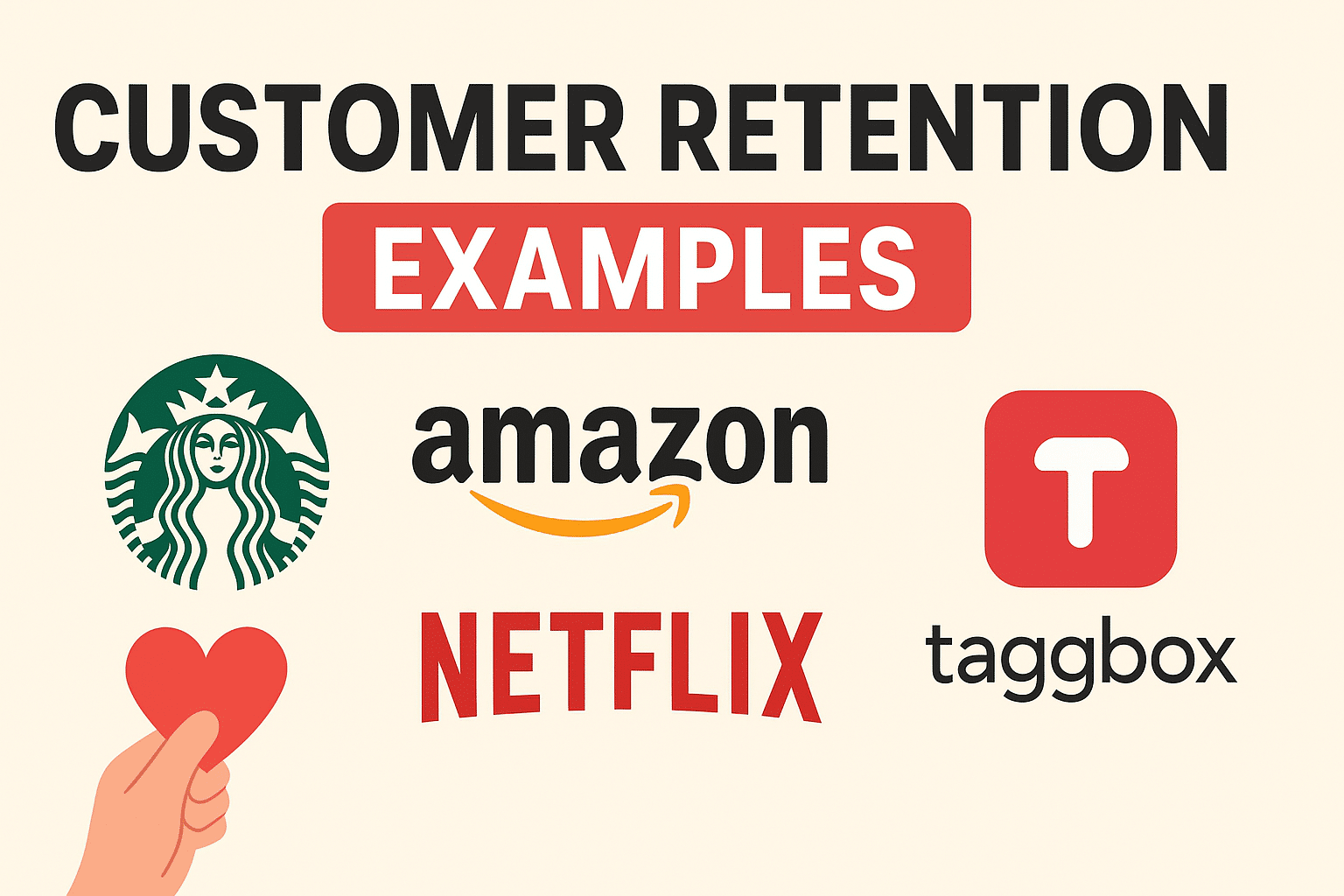In today’s competitive business landscape, customer acquisition often takes the spotlight. But innovative brands know that the real secret to long-term success lies in customer retention — keeping existing customers happy, engaged, and coming back.
Studies show that retaining a customer costs five times less than acquiring a new one. Moreover, even a slight 5% increase in customer retention can boost profits by up to 95%. With such impressive numbers, it’s clear why global brands focus heavily on retention-driven marketing strategies.
In this article, we’ll explore what customer retention is, why it matters, and share real-life UGC examples from brands like Starbucks, Amazon, Netflix, Sephora, Apple, and Taggbox that have mastered customer retention.
What Is Customer Retention?
Customer retention is a business’s ability to keep its existing customers over time and encourage repeat purchases. It focuses on building lasting relationships, enhancing satisfaction, and creating consistent value that encourages loyalty.
Unlike customer acquisition, which focuses on attracting new customers, retention focuses on maximizing lifetime value (CLV) by ensuring people continue to engage with your brand.
Standard metrics to measure customer retention include:
- Customer Retention Rate (CRR): The percentage of customers who stay over a given period.
- Repeat Purchase Rate (RPR): The number of returning buyers compared to total customers.
- Customer Lifetime Value (CLV): The total revenue a business can expect from one customer during their relationship.
These metrics help businesses track whether their customers are just buying once or becoming loyal brand advocates.
Why Customer Retention Matters More Than Ever
In 2025, retention is no longer optional — it’s essential for sustainable growth.
Here’s why:
- It’s cheaper than acquisition: Attracting new customers requires UGC ads, marketing campaigns, and time. Retention leverages existing relationships for repeat sales.
- It builds trust and brand advocacy: Loyal customers don’t just buy again — they recommend your brand to others.
- It boosts ROI and long-term stability: Returning customers are more likely to explore new products or services.
- It helps you survive competition: With so many choices online, loyal customers give your brand a stable foundation.
Retention is not just a marketing goal — it’s a reflection of your brand’s overall customer experience strategy.
6 Customer Retention Examples From Leading Brands
Now let’s explore how some of the world’s most successful companies have nailed customer retention with creative, personalized, and value-driven strategies.
1. Starbucks – The Power of Personalized Rewards
Starbucks Rewards Program is one of the most successful customer retention strategies in the world. The app gamifies the coffee-buying experience by rewarding users with stars, discounts, and personalized offers.
Customers earn stars for every purchase, which can be redeemed for free drinks, food, or exclusive merchandise. Starbucks also uses customer data — like location, purchase history, and preferences — to send personalized notifications and seasonal recommendations.
Retention takeaway:
Personalization + rewards = loyalty.
By making customers feel recognized and rewarded, Starbucks turns casual buyers into long-term fans who visit regularly.
2. Amazon – Prime Membership & Ecosystem Lock-In
Amazon’s Prime Membership is a masterclass in retention through convenience and exclusivity.
For a yearly subscription, users enjoy benefits like free delivery, Prime Video, Prime Music, and early access to deals. This ecosystem creates a strong sense of belonging and delivers consistent value across multiple platforms.
Once customers become Prime members, they tend to buy more frequently and are less likely to switch to competitors.
Retention takeaway:
Offer exclusive value and convenience that integrates seamlessly into your customers’ daily lives.
3. Netflix – Personalized Content Keeps Viewers Hooked
Netflix doesn’t rely on discounts or loyalty points — its retention power lies in personalization and content relevance.
Its algorithm studies viewing habits, genres, and even watch times to create a unique homepage for every user. By consistently offering fresh, personalized recommendations, Netflix keeps users engaged for hours, and subscribed for years.
The brand also invests heavily in original content and data analytics to ensure there’s always something new that fits each audience segment.
Retention takeaway:
Personalization and consistency are key to keeping users emotionally connected and less likely to churn.
4. Sephora – Tiered Loyalty That Feels Rewarding
Sephora’s Beauty Insider Program is one of the best examples of a tier-based loyalty program that drives repeat purchases.
Members earn points for every dollar spent, which can be redeemed for samples, discounts, or beauty experiences. The higher you go — from Insider to VIB to Rouge — the more exclusive perks you unlock, such as free shipping, birthday gifts, and event invitations.
Beyond points, Sephora builds an emotional connection by nurturing a community of beauty enthusiasts through its app and social media.
Retention takeaway:
Give customers a reason to stay — and climb higher — through tiered rewards and community-driven engagement.
5. Apple – Seamless Ecosystem Retention
Apple’s retention strategy doesn’t depend on loyalty points or offers. Instead, it creates an ecosystem so seamless that customers naturally stay.
When you buy an iPhone, it syncs effortlessly with your iPad, MacBook, and Apple Watch. The continuity of user experience, device compatibility, and consistent product quality ensure that switching brands feels inconvenient.
Apple also focuses on exceptional customer service, brand prestige, and a user-friendly environment — which builds both loyalty and advocacy.
Retention takeaway:
Build a connected ecosystem and offer experiences so smooth that customers can’t imagine leaving.
6. Taggbox – Retention Through Engagement & Authenticity
While most examples come from global B2C brands, platforms like Taggbox show how customer retention also thrives in the B2B world.
Taggbox helps brands collect, curate, and embed User-Generated Content (UGC) from social platforms such as Instagram, X (formerly Twitter), Facebook, and TikTok. By showcasing authentic customer stories and visuals, brands build social proof that boosts trust and engagement.
Many companies retain their customers by using Taggbox’s dynamic solutions such as:
- Social Media Widgets to embed live feeds on websites
- Shoppable Galleries to enhance product discovery
- UGC Walls for events and campaigns
By helping businesses engage customers authentically, Taggbox ensures that its clients see higher conversions and stronger brand-customer relationships — both key factors in retention.
Retention takeaway:
Engagement and authenticity are modern drivers of customer loyalty. When customers see real people loving a brand, they’re more likely to trust and stick around.
Key Takeaways From These Customer Retention Examples
Let’s summarize what these leading brands teach us about customer retention:
- Personalization is power – Tailor every interaction based on customer data and preferences.
- Reward loyalty – Incentivize repeat purchases through points, perks, or exclusive experiences.
- Offer convenience and consistency – Make your product indispensable to everyday life.
- Build emotional connections – Create community-driven experiences that go beyond transactions.
- Leverage authenticity – Use real customer voices (UGC) to build trust and credibility.
- Make feedback a loop – Continuously listen and evolve based on customer insights.
The key theme across all examples: Retention is not a one-time effort — it’s a long-term commitment to customer happiness.
How to Build Your Own Customer Retention Strategy
Now that you’ve seen how big brands do it, here’s how you can design your own customer retention plan — no matter your business size.
Step 1: Understand Your Customers
Use surveys, analytics, and social media insights to understand what your customers love and what they don’t. Personalization begins with data.
Step 2: Personalize Every Interaction
Send custom recommendations, birthday discounts, or loyalty-based offers. Show your customers they’re more than just numbers.
Step 3: Reward Repeat Behavior
Start a loyalty or referral program — even simple rewards can make a big difference. Recognize returning customers with early access or special perks.
Step 4: Engage Through Authentic Content
Use User-Generated Content (UGC) to build emotional connection and authenticity. Platforms like Taggbox make it easy to collect and showcase UGC from social media directly on your website or store pages.
Step 5: Deliver Consistent Value
Consistently deliver what you promise — whether it’s product quality, service response, or delivery speed. Consistency earns trust.
Step 6: Collect Feedback & Improve
Encourage customers to leave reviews and suggestions. Show them you’re listening by acting on their feedback.
Future of Customer Retention in 2025 and Beyond
The next phase of customer retention is all about experience and trust.
Trends shaping the future include:
- AI-powered personalization: Smarter recommendations based on behavior and emotion.
- Community engagement: Brands building spaces for customers to connect and share.
- Authenticity-first marketing: Real stories outperform polished campaigns.
- Integration of social proof tools like Taggbox to embed real-time engagement directly on websites and online stores.
As customers grow more conscious and digitally connected, businesses that combine authenticity, personalization, and convenience will stand out.
Conclusion
Customer retention is no longer just about keeping customers — it’s about creating brand advocates who love your product, recommend it, and stick with you long-term.
From Starbucks’ rewards to Netflix’s personalization, Amazon’s convenience, and Taggbox’s authenticity-driven engagement, each example shows that successful retention strategies share one thing in common — they put customers at the heart of every decision.


